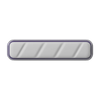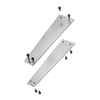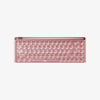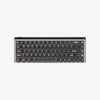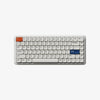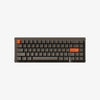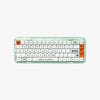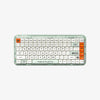어떤 기계식 키보드 스위치가 가장 조용한가요?

기계식 키보드는 독특한 타건감을 자랑하며, 뛰어난 내구성, 신뢰성, 그리고 신뢰성으로 잘 알려져 있습니다. 기계식 키보드는 각 키 아래에 개별 스위치가 내장되어 있어 타이핑 속도와 정확도가 향상됩니다.
사운드 레벨 및 스위치 유형 스위치 유형은 촉각적 반응뿐만 아니라 타이핑 시 발생하는 소리에도 영향을 미칩니다. 소음 수준은 많은 사용자에게 중요한 요소이며, 특히 조용하거나 다른 사람과 함께 사용하는 환경에서 더욱 그렇습니다.
조용한 스위치의 기준
스위치 노이즈에 영향을 미치는 요인
- 스위치 구성 요소에 사용되는 재료플라스틱이나 금속과 같은 재질은 소리에 영향을 줄 수 있습니다. 일반적으로 부드러운 재질일수록 소음이 적습니다.
- 스위치의 설계 메커니즘: 댐핑 메커니즘이 있는 스위치나 랜딩 패드에 쿠션이 있는 스위치는 키를 누르고 놓을 때 발생하는 소음을 최소화합니다.
소음 수준 및 테스트 표준
- 키보드 소음 수준 측정 방법: 소음 수준은 종종 데시벨로 측정됩니다. 표준화된 시험에는 평균 및 최대 소음 수준을 측정하도록 제어된 환경에서 타이핑하는 것이 포함될 수 있습니다.
가장 조용한 기계식 스위치 리뷰
선형 스위치
-
체리 레드 사일런트
- 명세서: 이 스위치는 소음을 최소화하고 촉각 피드백 없이 부드러운 키 입력을 유지하도록 설계되었습니다. 일반적으로 45dB로 작동하며, 이는 기계식 스위치보다 훨씬 조용합니다.
- 사용자 실험: 사용자들은 타이핑 소음을 상당히 줄일 수 있다고 보고하는데, 이는 늦은 밤 게임이나 사무실 환경에 완벽합니다.
-
게이트론 사일런트 블랙
- 명세서: 이 스위치에는 내부 댐핑 패드가 있으며 Cherry MX Silent Red와 비슷하지만 더 큰 작동력이 필요합니다.
- 사용자 실험: 이 제품은 조용하고 부드럽게 작동하는 것으로 알려져 있지만, 일부 사용자는 이 제품이 Cherry 제품보다 단단하다고 지적했습니다.
촉각 스위치
-
ZealPC 질렌츠
- 사양 및 소음 수준 이 스위치는 촉각 피드백을 제공하며, 끝부분의 스트로크를 줄여 소음을 줄입니다. 이 스위치는 고급 촉각 스위치와 유사하지만 소음 감소 기능이 있습니다.
- 사용자 실험: 팬들은 촉각적 충격, 조용한 작동, 성능 저하 없이 게임과 타이핑에 적합하다는 점을 높이 평가합니다.
-
Aliaz 무음 스위치
- 사양 및 소음 수준: 이 스위치는 조용하고 촉감이 좋도록 설계되었습니다. 또한 스위치에 고무 부품이 포함되어 있습니다. 이 스위치는 ZealPC Zilents보다 약간 더 조용합니다.
- 사용자 실험: 사용자들은 소음 감소와 촉각적 반응의 균형을 칭찬하며, 이 제품은 여러 사람이 함께 사용하는 환경에서 선호되는 선택이 되었습니다.
조용한 스위치의 혁신 기술

댐핑 소재 제조업체에서는 키 입력으로 인한 소음을 줄이기 위해 다양한 댐핑 소재를 개발했습니다.
- 고무 O링: 키캡 바닥에 이 O링을 설치하면 키가 보드에 닿을 때 나는 소리를 줄여줍니다.
- 폼 패드: 일부 스위치에는 키보드 섀시에서 에코를 줄이기 위해 스위치 하우징 내부에 소리를 흡수하는 폼 패드가 들어 있습니다.
특허받은 디자인 스위치의 디자인 또한 소음 감소에 도움이 됩니다.
- 소음 감소 기술많은 브랜드가 스위치를 더 조용하게 만드는 특허 기술을 개발했습니다. 예를 들어, Cherry의 MX Silent 스위치는 스위치에 내장된 고무 댐핑 장치를 사용하여 키를 누르고 놓을 때 발생하는 소음을 줄여줍니다.
- 무소음 기술 비교: ZealPC나 Gateron과 같은 브랜드는 데시벨을 최소화하고 좋은 촉각 반응을 유지하도록 설계된 스위치를 사용합니다. 예를 들어 ZealPC Zilents 스위치는 촉각 충격 전에 작동하는 댐퍼를 탑재하고 있습니다. 이는 촉각적 경험을 저해하지 않으면서 소리를 효과적으로 줄여줍니다.
올바른 조용한 스위치를 선택하는 방법
개인적 선호도를 고려하세요 스위치를 선택할 때는 타이핑에 대한 개인적 선호도와 조용함의 필요성 사이에서 균형을 맞추는 것이 중요합니다.
- 타이핑 느낌 vs. 소음 수준: 부드러운 직선형 키감과 촉각적인 느낌 중 어떤 것을 선호하는지, 그리고 소음 수준도 고려해 보세요. 선형 스위치는 촉각적 또는 클릭형 스위치보다 일반적으로 조용합니다.
- 작동력 및 이동 거리: 이 두 가지 요소 모두 키 감촉에 영향을 미칩니다. 일부 사용자는 더 가벼운 터치감과 짧은 키 이동 거리를 선호하는데, 이는 본질적으로 소음이 적기 때문입니다.
키보드와 호환 가능 선택한 스위치가 키보드와 호환되는지 확인하세요.
- 키캡과의 호환성대부분의 기계식 스위치는 표준 스템 모양(Cherry MX 스위치 등)을 가지고 있지만, 일부 스위치는 특정 키캡이 필요합니다.
- PCB 호환성: 스위치가 키보드 PCB와 호환되는지 확인하세요. 일부 키보드는 3핀 또는 5핀 스위치를 사용합니다. 일부 PCB는 핫스왑 방식으로 스위치를 교체할 수 있어 납땜 없이도 쉽게 교체할 수 있습니다.
설치 및 유지 관리

조용한 스위치 설치
DIY 설치 팁
- 올바른 도구를 얻으세요키보드를 핫스왑할 수 없는 경우 키캡 제거기, 스위치 제거기가 필요하며, 납땜 세트도 필요할 수 있습니다.
- 자세한 가이드를 사용하세요: 새로운 스위치를 설치하거나 오래된 스위치를 교체하는 과정을 안내하는 온라인 튜토리얼과 비디오 가이드가 많이 있습니다.
일반적인 과제와 해결책
- 납땜 과제키보드의 오래된 스위치를 납땜 제거해야 하는 경우, 적절한 납땜 인두와 납땜 제거 도구가 있는지 확인하세요. 인내심을 갖고 주의 깊게 작업하여 PCB 손상을 방지하세요.
- 스위치 정렬새로운 스위치를 설치할 때는 키가 눌릴 때 문제가 발생하지 않도록 스위치가 올바르게 정렬되고 단단히 고정되었는지 확인하세요.
조용한 성능 유지
청소
- 정기적인 청소: 먼지, 이물질 및 기타 입자는 스위치 성능과 소음 수준에 부정적인 영향을 미칠 수 있습니다. 압축 공기, 부드러운 칫솔, 부드러운 천으로 키보드를 정기적으로 청소하십시오.
- 매끄럽게 하기: 스위치에 윤활제를 바르면 마찰과 소음을 줄일 수 있습니다. Krytox나 Tribosys 같은 키보드 스위치 윤활제를 사용하세요.
마모된 부품 교체
- 체크 마모시간이 지남에 따라 스프링과 댐퍼가 마모될 수 있습니다. 최적의 성능과 소음 감소를 위해 마모된 부품을 교체하고 스위치를 정기적으로 점검하세요.
자세한 내용은 여기에서 확인할 수 있습니다.
가장 조용한 기계식 스위치 유형에 대한 요약
- 선형 스위치: Cherry MX Silent Red와 Gateron Silent Black은 모두 조용하고 부드러운 작동으로 인기가 많습니다.
- 촉각 스위치ZealPC Zilents 또는 Aliaz Silent Switch는 더 조용한 촉각적 경험을 제공하며, 큰 클릭음 없이 피드백을 선호하는 사용자에게 선호됩니다.
성능과 사운드의 균형에 대한 마지막 생각 조용한 기계식 키보드 스위치를 찾으려면 타이핑 느낌과 작동에 대한 개인의 선호도와 조용한 환경을 조성해야 하는 필요성 사이에서 균형을 맞춰야 합니다. 적합한 스위치는 편안함과 성능을 향상하는 동시에 소음 수준을 줄여줍니다.
적절한 설치 및 유지 관리 절차를 따르면 조용한 기계식 키보드를 좋은 상태로 유지할 수 있습니다. 이렇게 하면 오랫동안 뛰어난 타이핑 경험을 누릴 수 있습니다.
자주 묻는 질문
-
오늘날 가장 조용한 기계식 스위치는 무엇입니까?
- 조용한 붉은색, 그리고 조용한 블랙오늘날 가장 조용한 기계식 스위치로 많은 사람들이 꼽습니다. 이 스위치는 정숙성을 고려하여 설계되었으며, 타이핑 시 소음을 줄여주는 내부 댐핑 시스템을 탑재하고 있습니다. 질렌츠 게다가 Aliaz 무음 스위치 다른 주목할 만한 예도 있습니다. 두 제품 모두 소리를 줄이면서도 촉각적 피드백을 제공합니다.
-
키보드 스위치의 사운드 레벨을 어떻게 측정합니까?
- 데시벨 미터를 사용하여 키보드 스위치에서 발생하는 소리를 측정할 수 있습니다. 이러한 장치는 소음을 수치로 측정합니다. 많은 스마트폰 앱도 소음 수준을 대략적으로 측정할 수 있지만, 정확도는 떨어집니다. 마이크를 사용하여 타이핑 소리를 녹음한 후 유사한 조건에서 녹음된 다른 소리와 시각적, 청각적으로 비교할 수도 있습니다.
-
기존 키보드를 변경하지 않고도 스위치를 변경하면 키보드 소음을 줄일 수 있을까요?
-
스위치를 바꾸지 않고도 키보드를 더 조용하게 만들 수 있는 방법이 여러 가지 있습니다.
- 오링을 설치하세요. 이것은 키를 끝까지 눌렀을 때 나는 딸깍거리는 소리를 줄여줍니다.
- 데스크 매트 사용: 공명을 줄이려면 키보드 아래에 두껍고 부드러운 책상 매트를 놓으세요.
- 스위치 윤활: 적절한 윤활제를 바르면 소음과 마찰을 줄일 수 있습니다. 이를 위해서는 각 스위치를 열어야 합니다. 하지만 모든 키보드에 적용되는 것은 아닙니다.
- 키보드 케이스에 소음 흡수 폼 추가키보드 케이스에 소리 흡수 폼을 추가하면 키 밑에서 나오는 소리를 줄이는 데 도움이 됩니다.
-
스위치를 바꾸지 않고도 키보드를 더 조용하게 만들 수 있는 방법이 여러 가지 있습니다.
-
무음 스위치를 사용하는 것의 장점과 단점은 무엇입니까?
-
무소음 스위치에는 몇 가지 단점이 있습니다.
- 촉각 피드백 감소일부 무소음 스위치는 무소음 스위치보다 촉각적 입력감이 떨어집니다. 이는 일부 사용자의 타이핑 정확도와 만족도에 영향을 미칠 수 있습니다.
- 느낌: 무소음 스위치 소재는 기존 스위치보다 더 부드러운 느낌을 줄 수 있습니다.
- 비용무소음 스위치는 소음을 줄이기 위해 사용된 재료와 기술 때문에 가격이 더 비쌉니다.
- 제한된 옵션표준 스위치보다 무소음 스위치가 적습니다. 이로 인해 브랜드와 느낌 측면에서 선택이 제한될 수 있습니다.
-
무소음 스위치에는 몇 가지 단점이 있습니다.





